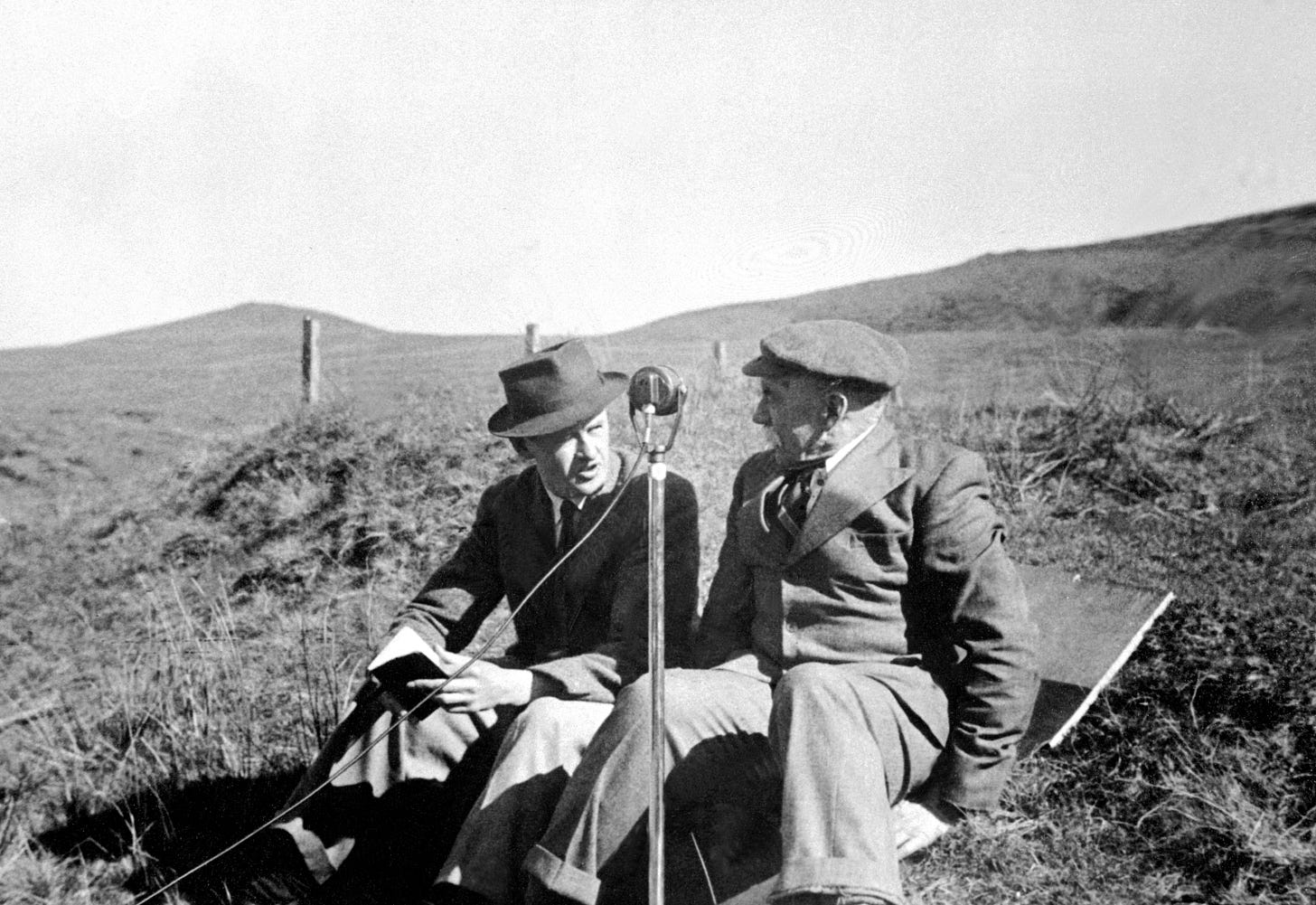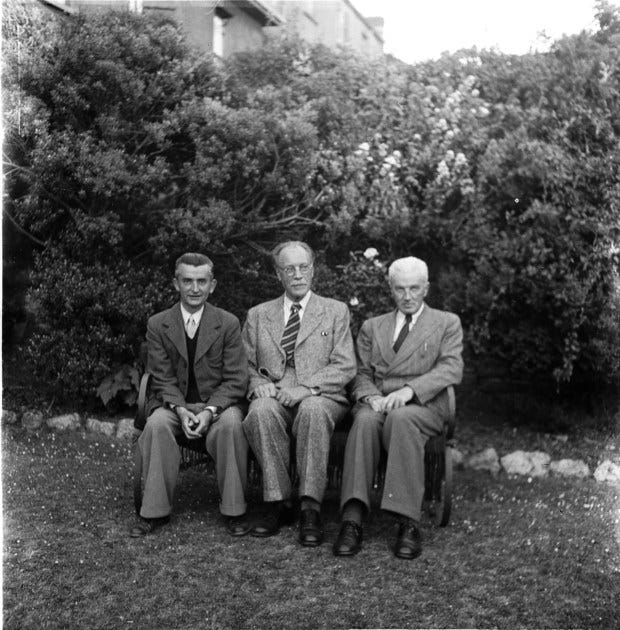The Myth and Measure of the Returned Yank, Part Two: The Irish Folklore Commission
by Maeve Carey-Kozlark
The Irish Folklore Commission (IFC) was founded by the 8th Dáil in the years preceding Ireland’s Constitution and leaves behind a decades-long legacy of cultural, linguistic, and ideological preservation. From 1935 until its absorption into the Department of Irish Folklore at University College Dublin in 1971, the IFC regularly prescribed and adapted guidelines for the collection and preservation of Irish folk tradition and history of all forms.1 Through WWII, the IFC was primarily known for and focused on the recording of Irish and Irish-adjacent song and language, with one of its most notable achievements being its 1948 Ediphone recordings of the rapidly dwindling number of Manx Gaelic speakers on the Isle of Man.2 As the Marshall Plan made landfall (see part one here for more), the Irish Folklore Commission became increasingly focused on establishing a distinct Irish national identity that was specifically independent of any American influence. Despite this, American researcher Arnold Schrier proposed in 1954 that the Commission gather information on Irish emigration to and from the United States––specifically to gauge whether the “pull” of American opportunity was more powerful than the “push” of the state of affairs in Ireland.

The IFC agreed to fund the project in 1955, and sent a team of field researchers to Irish villages in the west and south––the regions which had seen the highest rates of population loss––equipped with a 13-section bilingual questionnaire developed by both Schrier and IFC archivist Seán Ó Súilleabháin.3 The field teams presented this series of questions to all interviewees covering a wide range of aspects concerning emigration to the United States, including:
1. Who emigrated?
2. What were the reasons for emigrating?
3. Describe ‘American Wakes’. Who attended them?
4. Who were these ‘Wakes’ held for? When did the custom stop?
5. What songs, stories or ballads existed concerning emigration?
6. Did any expressions or sayings taken from American letters home become traditional when referring to America?
7. Were American letters regarded sarcastically?
8. How were American letters read? Aloud? Communally? In church, etc.?
9. Were gifts of money/remittances sent home from America? How was the money spent? 10. What of the returned emigrants?
11. Why did some emigrants return to Ireland to stay? Did they try to introduce American ways?
12. Do any of the American letters still exist?
13. Any additional comments or material?
The tenth series of questions read as follows:
“A considerable number of emigrants often returned to or visited their native land. Did they create a favorable impression?
Were they sought after for information on America?
Did they try to persuade others to emigrate?
Was their clothing admired or habits of dress copied?
Did they cause resentment because of bragging or “showing off” their wealth?”4

The massive and ongoing migration to the United States (and, in lesser quantities, Britain, Canada, and Australia) from the famine period onward radically altered Irish society and implicitly raises the question how a culture accommodates the trauma of the repeated loss of generations.5 From the vantage point of the United States, Irish numbers comprise one of the most significant ethnic groups in America, particularly in the nineteenth century; by 1845, 45 percent of immigrants had originated in Ireland.6 Employers primarily recruited the Irish to low-waged industrial work and, as with most immigrant groups during this period and today, chain migration facilitated further immigration and created communities of shared experience in which to settle. Over time, they developed the distinct hyphenate identity of “Irish-American.”
Less familiar and substantial than the tale of Irish emigration to the United States is the story of return migration to Ireland that Schrier sought to uncover. Various sources have estimated that during this era of mass emigration to the United States, between one quarter to one third of all European immigrants permanently returned home; some suggest that this total may have reached as high as four million in the early decade of the twentieth century, given the economic downturn and restrictive laws of the time.7 By contrast with Italian ritornati and Greeks who returned in substantial numbers to their native countries, or those who followed the “birds of passage” cycle (coming to the United States for work, returning home when the economy suffered, then coming back when it improved, rinse, repeat) the Irish by and large tended to settle in America, albeit maintaining regular contact with and often sending money to the relatives they left behind.8 Historian Mark Wyman reveals that fewer than fifteen percent of the Irish who emigrated to the United States after the famine generation ever returned home with an express intent to stay.9
Given these low numbers, it is unsurprising that few respondents answered the questions in series 10 with much substance, ultimately leading Schrier to the conclusion that “the Returned Yank was at best an adapter, whose roots were essentially in Irish soil, and yet one who was not respected as a true bearer of new gifts … [he] was more still an Irishman than an American even with his American experiences…[his] impact on rural society was a negligible one.”10
Of course, the changing of dress or work habits of one’s former neighbors (or lack thereof) is hardly a reliable metric for social and cultural impact. As historian Ann Schofield notes, the presence of the Returned Yank in the Irish cultural imagination long before his 1955 survey––as well as its persistence afterwards––point to a resilient cultural meaning beyond Schrier’s unambivalent use of the elusive yank as historical “evidence.”11 Schrier himself would later write in great detail of the several ballads that emerged in early 20th century Irish-American communities detailing real or desired pilgrimages from the United States back to Ireland. Hopes of finding prosperity in America, he argues, became increasingly tinged with realism during this time, with lyrical themes dismantling romanticized views of emigration:
If you want to earn money you must be fully inclined,
For there’s poor folk in America just as those left behind.
Ireland is often despised and faulted,
But that should not be so.
Not so is it in Boston,
Or in any other such state,
If a man should earn a dollar there,
His wife will be out drinking it.12
Several others went a step further in detailing explicit promises to return:
And when I reach America
I’ll labour day and night
My purse to fill with golden coins
All beautiful and bright.
And then for dear old Ireland
My passage I will take
To end my course in Briarfield
By the lovely Shad Lough Lake.13
A thorough examination of return migration literature and narratives in the early-to-mid 20th century reveals that Irish writers and dramatists tend to turn to the figure of the Returned Yank as a compelling device to interrogate broader issues of tradition versus modernity, as it possesses the ability to serve doubly as a nostalgic critic and the very embodiment of both of these concepts.14 It is precisely this quality that might explain the contradiction between the Irish preoccupation with the figure of the emigrant who returns and the low number of those who actually did return to their native land. Schofield contends a similar hypothesis; that “...the presence of the Returned Yank motif in Irish popular culture…provided the Irish with a cultural site where they assessed the cost and benefit of massive and ongoing population loss. [It] offered the Irish a way of constructing an Irish identity distinct from, yet in reference to, the diasporic Irish.”15
In spite of the low numbers of “yanks” who did in fact return and the almost mythological form they have since taken in Irish historiography and popular culture, a number of case studies nonetheless bring to the forefront significant, tangible examples of the impact of return migration on the Irish and Irish-American diasporic cultural landscape. Stay tuned for one of these in part three: the banjo!
Almqvist, Bo. “The Irish Folklore Commission: Achievement and Legacy.” Béaloideas 45/47 (1977): 12, 16.
O’Sullivan, S. “The Collection and Classification of Folklore in Ireland and the Isle of Man.” Folklore 68, no. 4 (1957): 449–57.
Ó Grada, Cormac. “The Population of Ireland 1700-1900: a survey.” Annales de démographie historique: statistiques de peuplement et politique de population (1978): 281-299.
Schrier, Arnold. Ireland and the American Emigration, 1850-1900 (University College Dublin Press, 1957): 90.
Ó Gráda, Cormac. “Famine, Trauma and Memory,” Béaloideas 69 (2001): 126.
Miller, Kerby A. Emigrants and Exiles: Ireland and the Irish Exodus to North America (Oxford, New York: Oxford University Press, 1988).
Gould, J.D. “European inter-continental emigration - the road home: return migration from the U.S.A.” Journal of European Economic History, IX (1980): 58-59.
The Great Arrival. (n.d.). Library of Congress. Accessed via https://www.loc.gov/classroom-materials/ immigration/italian/the-great-arrival/ (10 December 2023); Bernard, “Greek Return Migration,” Current Anthropology 19, no. 3 (1978); Hatton, Timothy J., and Jeffrey G. Williamson. “After the Famine: Emigration from Ireland, 1850-1913.” The Journal of Economic History 53, no. 3 (1993): 587-591.
Wyman, Mark. Round-Trip to America: The Immigrants Return to Europe, 1880-1930 (Cornell University Press, 1993): 126.
Schrier, Ireland and the American Emigration (1957), 210.
Schofield, Ann. “The Returned Yank as Site of Memory in Irish Popular Culture.” Journal of American Studies 47, no. 4 (2013): 1180.
Schrier, Arnold. “Ireland and the American Emigration, 1850-1900.” PhD diss. Northwestern University (1956): 95.
Field notebook of JJ O’Donnell, Irish Folklore Commission, as referenced by Schrier (1956): 97.
Cleary, Joe. “Modernization and Aesthetic Ideology in Contemporary Irish Culture,” Writing in the Irish Republic: Literature, Culture, Politics 1949–1999, (London: Macmillan, 2000): 113–14.
Schofield (footnote 11), 1182.

